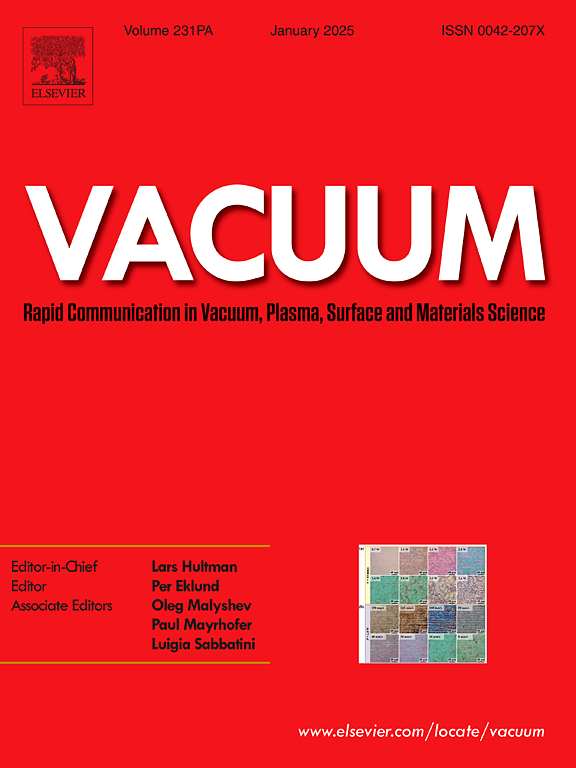Combined plasma diagnostic approaches for characterization of pulsed-DC driven hollow cathode discharge in a metal tube based on current-voltage characteristics, Langmuir probe, and optical emission spectroscopy
IF 3.9
2区 材料科学
Q2 MATERIALS SCIENCE, MULTIDISCIPLINARY
引用次数: 0
Abstract
Pulsed vacuum discharge is widely used in the deposition of films on the inner walls of tubes for lubrication and corrosion prevention. However, the mechanisms by which plasma impacts this process keep ambiguous due to the limited knowledge about plasma characteristics such as spatial-temporal evolution and discharge in tubes of various diameter and length. In this study, high-voltage pulsed-DC driven hollow cathode discharge (HCD) is performed on a metal tube system for the deposition of anti-corrosive films on the inner surface. The current-voltage (CV) characteristics are analyzed in addition to Langmuir probe diagnostics and optical emission spectroscopy (OES). A brief voltage breakdown occurs at the beginning of the discharge, lasting approximately 3–4 μs, but the discharge quickly stabilizes, followed by a steady voltage state. The voltage cathode drop (Uc) is sufficiently high to sustain the discharge, thereby generating secondary electrons (γ-electrons) for excitation and ionization. And, a full HCD is established with a sufficient quantity of γ-electrons at higher discharge voltages (e.g., magnitude lager than 4000 V in our case), indicating that substantial voltage levels are necessary to develop adhesive, high-quality films. The discharge persists even after reaching the peak discharge current, as indicated by the temporal distribution of electron density and emission line ratios obtained from the Langmuir probe and OES measurements, respectively. In conjunction with the Langmuir probe measurements, the effective prediction of electron density and temperature using OES, based on the collision radiative (CR) model, reveals a more suitable method for evaluating plasma properties within tubes, enhancing the understanding of plasma-assisted film growth. Overall, the discharge characteristics, especially the pulse-driven evolution, can be better characterized by CV and Langmuir probe measurements. These reveal the evolution mechanisms of discharge voltage, density, and γ-electrons, which impact film properties such as brittleness induced by insufficient HCD. OES-CR provides a convenient, non-intrusive means to determine plasma radicals and densities, evaluating their effects on film formation, despite limitations in small-diameter tubes which are difficult for intrusive measurements. This comparative investigation thus elucidates the discharge characteristics and feasible methods for revealing the underlying mechanisms associated with pulse-driven discharges and film deposition in diverse tube configurations.
基于电流电压特性、Langmuir探针和光学发射光谱的金属管内脉冲直流驱动空心阴极放电的联合等离子体诊断方法
脉冲真空放电被广泛应用于在管道内壁沉积薄膜,用于润滑和防腐。然而,等离子体影响这一过程的机制由于对等离子体的时空演变和不同直径和长度的管中的放电等特性的了解有限而不明确。在本研究中,采用高压脉冲直流驱动的空心阴极放电(HCD)方法,在金属管系统的内表面沉积防腐膜。除了Langmuir探针诊断和光学发射光谱(OES)外,还分析了电流-电压(CV)特性。放电开始时出现短暂的电压击穿,持续时间约为3-4 μs,但放电很快稳定下来,随后进入稳定电压状态。阴极电压降(Uc)足够高,以维持放电,从而产生二次电子(γ-电子)激发和电离。并且,在更高的放电电压(例如,在我们的情况下,大于4000 V的量级)下,用足够数量的γ-电子建立了一个完整的HCD,这表明需要大量的电压水平来开发粘接的高质量薄膜。从Langmuir探针和OES测量分别获得的电子密度和发射线比的时间分布可以看出,即使在达到峰值放电电流后,放电仍然持续。结合Langmuir探针测量,基于碰撞辐射(CR)模型,利用OES有效预测电子密度和温度,揭示了一种更适合评估管内等离子体特性的方法,增强了对等离子体辅助薄膜生长的理解。总体而言,CV和Langmuir探针测量可以更好地表征放电特性,特别是脉冲驱动的演变。这揭示了放电电压、密度和γ-电子的演化机制,它们会影响HCD不足引起的薄膜脆性等性能。OES-CR提供了一种方便、非侵入性的方法来测定等离子体自由基和密度,评估它们对膜形成的影响,尽管在小直径管中难以进行侵入性测量。这一对比研究阐明了放电特性和可行的方法,揭示了不同管道结构下脉冲驱动放电和薄膜沉积的潜在机制。
本文章由计算机程序翻译,如有差异,请以英文原文为准。
求助全文
约1分钟内获得全文
求助全文
来源期刊

Vacuum
工程技术-材料科学:综合
CiteScore
6.80
自引率
17.50%
发文量
0
审稿时长
34 days
期刊介绍:
Vacuum is an international rapid publications journal with a focus on short communication. All papers are peer-reviewed, with the review process for short communication geared towards very fast turnaround times. The journal also published full research papers, thematic issues and selected papers from leading conferences.
A report in Vacuum should represent a major advance in an area that involves a controlled environment at pressures of one atmosphere or below.
The scope of the journal includes:
1. Vacuum; original developments in vacuum pumping and instrumentation, vacuum measurement, vacuum gas dynamics, gas-surface interactions, surface treatment for UHV applications and low outgassing, vacuum melting, sintering, and vacuum metrology. Technology and solutions for large-scale facilities (e.g., particle accelerators and fusion devices). New instrumentation ( e.g., detectors and electron microscopes).
2. Plasma science; advances in PVD, CVD, plasma-assisted CVD, ion sources, deposition processes and analysis.
3. Surface science; surface engineering, surface chemistry, surface analysis, crystal growth, ion-surface interactions and etching, nanometer-scale processing, surface modification.
4. Materials science; novel functional or structural materials. Metals, ceramics, and polymers. Experiments, simulations, and modelling for understanding structure-property relationships. Thin films and coatings. Nanostructures and ion implantation.
 求助内容:
求助内容: 应助结果提醒方式:
应助结果提醒方式:


